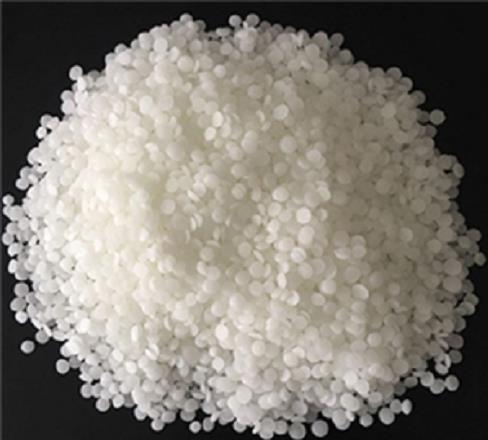| Identification | Back Directory | [Name]
POLYCAPROLACTONE AVERAGE MN CA. 42 500 | [CAS]
24980-41-4 | [Synonyms]
CURESORB-PCL
Lactel? BP-0800
Ploycarprolactone
Caprolactone oligomer
Dyed Polycaprolactone
aquaplast,caprolactone
2-Oxepanone polyesters
2-Oxepanone,homopolymer
Polycaprolactone - 81200
6-Hexanolide homopolymer
caprolactone homopolymer
Poly(ε-caprolactone) ,PCL
Poly(caprolactone), Flakes
PolycaprolactoneMn 70,000-90,000
.epsilon.-Caprolactone,homopolymer
Polycaprolactone average Mn 45,000
Polycaprolactone average Mn 80,000
Polycaprolactone Standard (Mw 2,000)
Polycaprolactone Standard (Mw 4,000)
Resomer(R) C 212, Poly(caprolactone)
Resomer(R) C 209, Poly(caprolactone)
Polycaprolactone Standard (Mw 13,000)
Polycaprolactone Standard (Mw 20,000)
Polycaprolactone Standard (Mw 40,000)
Polycaprolactone Standard (Mw 60,000)
Polycaprolactone Standard (Mw 100,000)
Polycaprolactone Standard (Mw 120,000)
Polycaprolactone Standard (Mw 200,000)
Polycaprolactone,viscosity >11.25 dL/g
OLYCAPROLACTONE AVERAGE MN CA. 42 500
POLYCAPROLACTONE AVERAGE MN CA. 42 500
POLYCAPROLACTONE, AVERAGE MN CA. 10,000
POLYCAPROLACTONE, AVERAGE MN CA. 80,000
Polycaprolactone,viscosity 4.25~6.00 dL/g
Polycaprolactone,viscosity 6.00~8.25 dL/g
Polycaprolactone,viscosity 0.30~0.75 dL/g
Polycaprolactone,viscosity 0.75~1.25 dL/g
Polycaprolactone,viscosity 1.25~1.75 dL/g
Polycaprolactone,viscosity 1.75~2.25 dL/g
Polycaprolactone,viscosity 2.25~3.00 dL/g
Polycaprolactone,viscosity 3.00~4.25 dL/g
polycaprolactone (average MW 1000-1000000)
Polycaprolactone,viscosity 8.25~11.25 dL/g
Poly(caprolactone), Av. Mn (by GPC) 80,000, Pellets
POLY(EPSILON-CAPROLACTONE) (AVERAGE MW ABOUT 10,000)
Resomer(R) C 212, Poly(caprolactone) ester terminated
Polycaprolactone,ester terminated,viscosity ~01.5 dL/g
Polycaprolactone,ester terminated,viscosity 3.00~4.25 dL/g
POLYCAPROLACTONE AVERAGE MN CA. 42 500 ISO 9001:2015 REACH
Polycaprolactone average Mw ~14,000, average Mn ~10,000 by GPC
Polycaprolactone,2-Oxepanone homopolymer, 6-Caprolactone polymer
Polycaprolactone average Mw ~14,000, average Mn ~10,000 by GPC, flakes
Poly(ε-caprolactone), medical grade, ester terminated, average M.W. 4,000 - 40,000
Poly(ε-caprolactone), medical grade, ester terminated, average M.W. 40,000 - 106,000
Poly(ε-caprolactone), medical grade, ester terminated, average M.W. 106,000 - 188,000
Poly(ε-caprolactone), medical grade, ester terminated, average M.W. 188,000 - 282,000
Poly(ε-caprolactone), medical grade, ester terminated, average M.W. 282,000 - 499,000 | [EINECS(EC#)]
244-492-7 | [Molecular Formula]
(C6H10O2)n | [MDL Number]
MFCD00084404 | [MOL File]
24980-41-4.mol | [Molecular Weight]
114.142 |
| Questions And Answer | Back Directory | [Description]
Polycaprolactone is a semi-crystalline polymer, a chemically synthesized biodegradable polymer material, its structural repeating unit has 5 non-polar methylene-CH2 starch, etc. Substance blending can make completely biodegradable materials. |
| Hazard Information | Back Directory | [Chemical Properties]
intrinsic viscosity 1.00-1.30 | [Uses]
Extrusion aid, die lubricant, mold release, pigment and filler dispersion aid and polyester segments in urethanes and block polyesters. | [Definition]
ChEBI: Hexano-6-lactone is a epsilon-lactone that is oxepane substituted by an oxo group at position 2. | [General Description]
Polycaprolactone (PCL) is a biodegradable, semicrystalline polyester for use in tissue engineering and drug delivery research applications. Due to the increased length of the aliphatic chain, polycaprolactone degrades significantly slower than other common biodegradable polymers, such as polylactide. PCL features a low melting point (55-60 °C), making it ideal for thermal processing and increasing its use in novel applications such as 3D bioprinting. In addition to its favorable thermal properties, PCL also features high solubility in organic solvent allowing for a multitude of other processing options. This product features low residual water, monomer, and catalyst (tin) making it an ideal choice for use in tissue engineering and 3D bioprinting research. | [Properties and Applications]
Polycaprolactone (PCL) is a biodegradable, semicrystalline polyester for use in tissue engineering and drug delivery research applications. Due to the increased length of the aliphatic chain, polycaprolactone degrades significantly slower than other common biodegradable polymers, such as polylactide. PCL features a low melting point (55-60 °C), making it ideal for thermal processing and increasing its use in novel applications such as 3D bioprinting. In addition to its favorable thermal properties, PCL also features high solubility in organic solvent allowing for a multitude of other processing options. This product features low residual water, monomer, and catalyst (tin) making it an ideal choice for use in tissue engineering and 3D bioprinting research. | [Reactivity Profile]
Polycaprolactone (PCL) is biodegradable polyester with a low melting point of around 60 °C and a glass transition temperature of about 60 °C. PCL is prepared by ring-opening polymerization of ε-caprolactone using a catalyst such as stannous octanoate[1]. Polycaprolactone is a semicrystalline linear polyester produced by ring-opening polymerisation of epsilon-caprolactone, which is commonly derived from fossil carbon. It has a much lower glass-transition temperature (Tg = ? 60 °C) than other biodegradable polymers, which assists its biodegradability despite its high degree of crystallinity, typically 50%[2]. | [Solubility in organics]
Chloroform, THF, toluene | [References]
[1] McKeen, L. “1 – Introduction to Use of Plastics in Food Packaging.” 2013. 1-15.
[2] Abdelhamid, Hani Nasser. “Biodegradable Polymer Nanocomposites.” 2023. 0. |
|
|